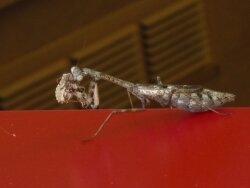They're back! Locals stock up on anti-stink bug artillery
Fall should mean apple cider, changing leaves, and fuzzy sweaters, but in the past few years, something less charming has been added to that autumn list: stink bugs. First there's one, crawling harmlessly on the side of your house. Then suddenly there are hundreds: crawling on every surface, finding their way into sleeves, curtains, even your hair.
But is the problem getting better or worse this year?
"It's spotty," says Brian Cecil, an employee at Martin Hardware. "In some places it's worse, in some places it's not. But overall, they're a problem."
As reported in the Hook last year, the brown marmorated stink bug, also known by its scientific name Halyomorpha halys, was first officially documented in Allentown, Pennsylvania, in 2001. Since that time, the Asian insect that releases a pungent odor when stressed has spread up and down the East Coast unhindered by natural predators and seeking a warm place– your house– to hibernate during winter.
Their numbers can be startling.
"You could hear them crawl," says Cecil, recalling the sight of a tarp outside a house in Faber covered so completely that "you couldn't see any blue."
"It was unsettling," he says with a chuckle, noting an influx of customers to the Preston Avenue hardware emporium seeking stink bug solutions including a new trap created specifically for the critters that Martin recently began stocking.
The Southern States Cooperative on Harris Street also has had the traps, which cost $19.95 and work outside by emitting a stink bug-attracting pheromone. They can be adapted for indoor use with a $20 light-emitting attachment. They're selling faster than Southern States can order them.
"We keep selling out," says manager Matt Porter, who notes that stink bug pesticide has been flying out the door as well.The traps– which simply catch the bugs but use no poison– are popular, he says, because they're nontoxic.
"Sales have been very strong" says Stephanie Cates, spokesperson for Sterling International, manufacturer of the Rescue! brand stink bug traps that are currently distributed in the six states hardest hit by the insect invasion: Pennsylvania, New Jersey, Delaware, Maryland, Virginia, and West Virginia.
"Obviously, it's a product in high demand," Cates says, "due to the panic people have when stink bugs are in their home."
That panic bothers naturalist Marlene Condon.
"Why people feel they have to do anything, I don't know," says Condon. "They don't reproduce in your house, they aren't going to bite you, they're not going to be after you, they're not going to damage your furniture. They're just there to escape the cold."
Condon says the use of pesticides to manage stink bug numbers is particularly troubling to her since it can kill other insects that might otherwise learn to eat stink bugs. Around her Albemarle County house, she says, praying mantises appear to have decided stink bugs are a tasty snack, and spiders are also making meals of the menaces.
"Those native animals need time to increase their population in order to bring down the population of stink bugs," says Condon, who notes the best defense against the bugs is making sure windows and doors are sealed tight so no insects can enter.
"When you see them getting inside, it's mother nature's way of letting you know you have a problem with your home," says Condon. "It means that you're wasting energy and A/C."
